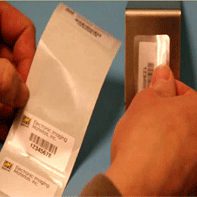When to use Laminated Labels
Labels are often challenged to perform with super-human strength and durability. We want them to be “permanent” and yet cleanly “removable.” We want them to hold up to constant abuse from moisture, temperature extremes, chemicals, solvents, abrasion, salt spray, acids, and so forth. We want them to fend off the much more expensive “arch-rival”—metal tags. Metal tags are, of course, the ULTIMATE labeling solution if you have the very worst of conditions or need LONG-term durability—up to 20 years or more. For this reason, EIM does provide a variety of anodized aluminum metal tags and labels for these special applications. 
Years ago, manufacturers of film label materials extended five-, ten- or twenty-year warranties. Unfortunately, however, companies got caught up in lawsuits and had to back off on such claims. Let’s face it . . . there are way too many variations in service conditions. What might work fine in the midwest may not hold up to the humidity of the Amazon River Basin or the ultra-cold of the tundra.
These days, you are more apt to find one-, two- or three-year service life guarantees with under-the-breath comments indicating that—within reasonable conditions—the labels have been “known to work” for much longer periods. To extend label life expectancy, many of us have come to depend upon adding a protective layer of clear film—also known as a clear over-laminate. This clear coating indeed protects printed images and provides an attractive finished look to a label. An over-laminate can even add strength and thickness to closely replicate the appearance of metal tags—particularly if you start with a silver base product such as metalized polyester. Laminates come with matte, glossy, and even textured finishes to meet a variety of preferences and needs.
To Laminate or Not to Laminate . . . That is the Question
Many of us from the “old school” of labeling automatically assume that the very “best” pressure-sensitive label MUST HAVE an over-laminate. While lamination adds some cost to the label—if it looks better, it must be better. (Learn more about parts of a label here).

Improvements in printing ribbons expanded the durability of printed labels. These improvements brought color to labels and high visual impact. Rather than a small handful of choices, we now have many variations ranging from soft-wax ribbons to high-end, highly chemical-resistant resins. We have dozens of spot colors, as well as process colors to provide high-quality images. The ribbons—combined with refinements in the label printers themselves—make for even higher resolution images up to 600 dpi. The one drawback is that there aren’t many colors that would not fade in long-term, outdoor conditions.
So, do we or don’t we need to laminate? Standard asset and property label applications may simply not need the extra protection. It’s only in the case of severe abuse that a clear laminate provides more service life. If we put a label on the back of a computer, does it get exposed to chemicals and solvents or is it more likely to receive just gentle dusting? If we put a label on a warehouse rack high above the work floor, just how durable does it need to be? On the other hand, if we label greasy tools that get bumped and scraped, the extra layer may give us more time before we ultimately have to replace the label because we can’t scan the barcode. Sometimes we deliberately choose to use a laminate to change the appearance of a label. For instance, a dull matte white label instantly becomes shiny with a glossy laminate for commercial appeal, while shiny silver laminated labels are dulled down with a matte laminate to make barcode scanning easier.
We were also accustomed to adding an over-laminate to provide UV resistance. Regular inks and printing ribbons only offer a certain amount of light resistance before they fade. (Fortunately, there were special overlay films such as pricey Tedlar® that extended the life of outdoor labels up to five years.) We are now entering the “New Age” of digital printing and UV inkjet inks. Not only can EIM print exceptionally durable labels in full color (process) without wasting printing ribbons, but we can also add UV resistance to your labeling. Our equipment prints faster and our inks provide chemical resistance while working on a wide variety of substrates. This system is far more environmentally friendly than solvent-based ink technologies and produces photo-quality images. We all want to do our part to promote environmental responsibility.
The choice to laminate is still entirely up to you. Our strong sense of the market indicates, however, that lamination will fast become the “exception” and not the “rule.” Contact our Label Experts to discuss any labeling and laminating concerns. We’re not superheroes in capes or costumes, although we make laminated labels that can “save the day”!
Tedlar® is the registered trademark of DuPont.




